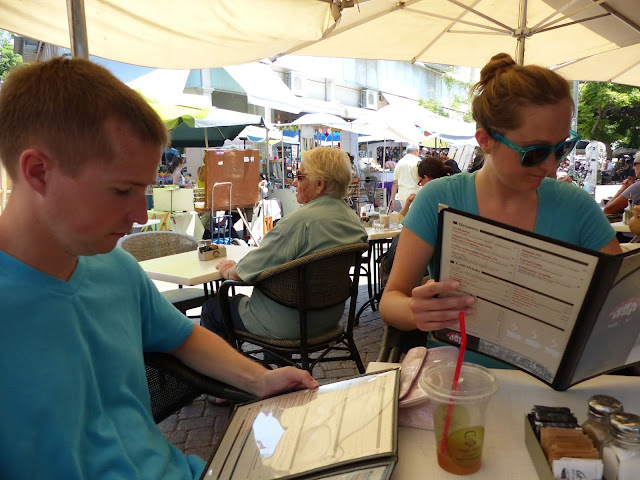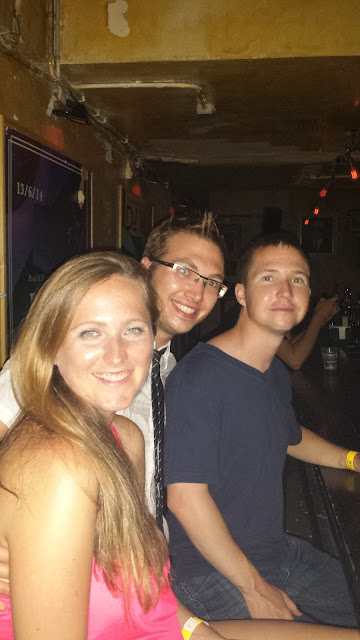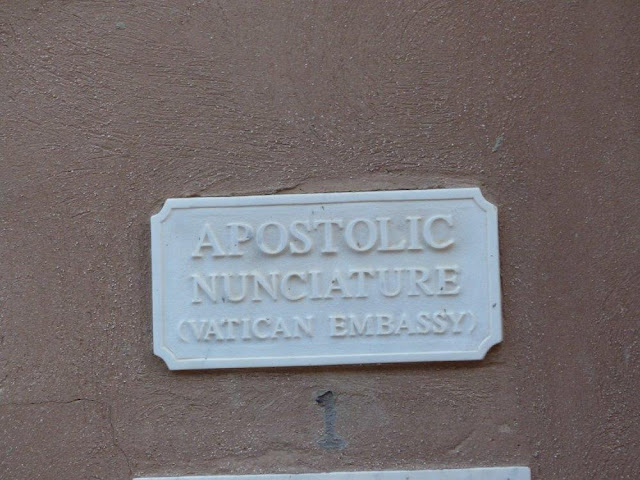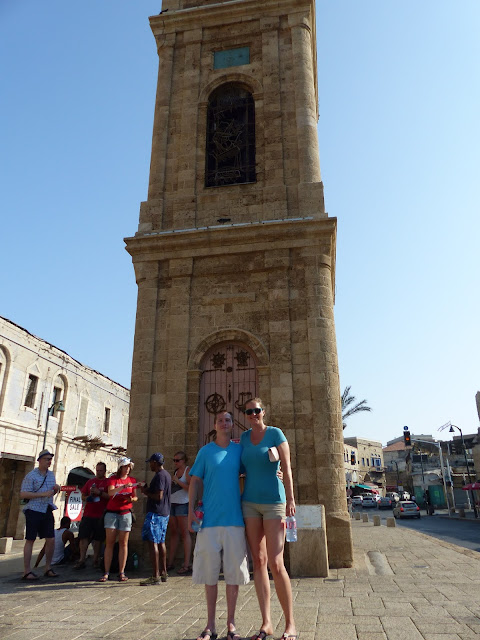A Weekend in a City That Doesn't Sleep
After several weekends exploring Israel's cultural and natural wonders, a group of us decided to break the mold and spend a weekend in a city where nightlife is one of the main attractions. That is not to say we did not indulge in some historical site seeing along the way, just that it was not the original focus of our trip.
 |
Enjoying some lunch at a patio restaurant in the Carmel Market.
|
Tel Aviv-Yafo are a pair of sister cities, much like Minneapolis-St. Paul, Minnesota. They share some burden of the municipal framework, but also exist independently with their own styles. Tel Aviv is a large European style city with lots of high rises, crowded beaches, and more bars and clubs than restaurants. Yafo (or Jaffa in the Arabic pronunciation) is the oldest continuously occupied port city in the world. With two evenings in Tel Aviv we split our time between these sister cities, with one night enjoying Tel Aviv's nightlife and the other soaking in Yafo's cultural heritage. In our itinerary Tel Aviv came first.
 |
| Enjoying ourselves in one of Tel Aviv's night clubs. |
Our hotel was located in the Allenby Street/Rothschild Street area, an area known for its nightlife. Walking around Tel Aviv after checking into our hotel was a little overwhelming. There were so many bars and clubs side by side, picking which one to have a drink in was daunting. So to make our decision easier, we singed up for a pub crawl which started with one beer on a hostel roof and moved on to four other bars and clubs in the area.
 |
| An archeological dig of Egyptian building remains in Jaffa. |
I must say while initially not fond of the idea of a guided tour of bars of Tel Aviv, I was plesantly surprised at the eclectic mix of bars we attended. We started off with a very chic whiskey bar with subdued back lighting in earthen tones, then moved on to an underground top 40s night club with so much base upon emerging I felt like I was listening through mufflers for twenty minutes. We then enjoyed the calm of an open air patio bar with Christmas lights, palm trees, 90s hip hop music, and surprising affordable drinks, before ending the crawl in another night club.
 |
| The winding streets and archways of Old Jaffa. |
In most cities after walking out of a night club at 4 AM with a slight buzz and a cheerful grin finding a late night snack would prove a problem, not in Tel Aviv where I was shocked at the number of open restaurants. We settled for some slices of New York style pizzas before bedding down for the night.
 |
| The Mediterranean is off in the distance in this photo of Old Jaffa. |
The next morning some of our group headed out to explore the city's museums. I slept in until lunch. We met back up at Tel Aviv's Carmel Market, a market with different streets dedicated to chic art, everyday needs from socks to yamikas, and produce and other food. Food stalls and restaurants interspersed within all the areas of the market. Wanting to rehydrate and prepare for the heat wave I started off with a passion fruit-organic goat yogurt smoothie which toted lots of B vitamins and antioxidants, but not before also sampling a tasty apple-ginger smoothie from the same stall. Feeling refreshed and hungry for more, we meandered down the market until finding a restaurant with a shaded outdoor patio for a leisurely lunch of a sabich sandwich (fried eggplant, sour pickles, hard boiled egg, and tahini). We walked around the shuk (a middle eastern market) a bit more before heading to Old Jaffa (Yafo) for a tour.
 |
| Modern art in Old Jaffa is abundant due to its artist colony statute. |
Old Jaffa is so old it is the oldest continually occupied port city in the world. It's been occupied by the Egyptians, Romans, Arabs, Crusaders, Jews, British, Ottoman Empire, Canaan, Persia, Assyria, France (Napoleon), and possibly some others that I am unaware of. Each time Jaffa was conquered, the city was destroyed and a new city with new architecture was built on top. The result today is that Jaffa sits on a hill of sorts comprised of the ruins of old civilizations. This specific type of archeological hill is called a tel (like Tel Aviv, except Tel Aviv is not on a tel at all, Jaffa is).
 |
| Another piece of art perched on the ledge of a building above the narrow streets of Old Jaffa below. |
Just like any other area of Israel, part of the archeology here in Jaffa is related to the bible. Jaffa is actually mentioned in the Old Testament as the city which Joshua sailed out of just before he was swallowed by a large fish for disobeying God. Jaffa makes an appearance in Greek mythology too. Jaffa is the port city where Andromeda was chained up as an offering to appease the angry God Poseidon, by allowing one of his sea monsters to eat the beautiful young woman. Of course a maiden in distress in these myths always needs a hero. In this case Perseus who had just lobbed of Medusa's head just happened to be flying by on his nikes when Poseidon's monster came out of the sea to eat Andromeda. Perseus used Medusa's severed head to turn the monster to stone, which crumpled to piles of rocks now seen off the shore of Old Jaffa.
 |
| Streets by ancient standards, the ancient streets of Old Jaffa are more like walkways today. |
Moving forward in time, the Christians came to Jaffa in the 1600s to build St. Peter's Church and Monastery overlooking the Mediterranean Sea, which not only acted (and still does to Catholics) as welcoming party to pilgrims but is also home to the Vatican's Embassy to the Holy Land. The vatican considers the Holy Land to include Israel, Egypt, Syria, Lebanon, Palestine, Jordan, Cyprus, and Rhodes. Catholic holy places (churches built on areas where specific miracles
supposedly happened and relics) in this domain are attended to by Franciscan Priests. Anyone who has seen Disney's version of Robin Hood will have welded within their brains the dress of Franciscan Priests who dress similarly to Friar Tuck in the movie. 16,000 strong they wear plain brown robes, with a white rope tied around their waist. On the ends of the white robe are three knots which signify the priest can have no money, have no wife, and can't do anything about it. In reality the knots signify their vows of poverty, celibacy, and obedience to the order.
 |
| The Vatican Embassy to the Holy Land, including but not limited to Israel, Palestine, Egypt, Syria, and Greece. |
It was thanks to a friendly Franciscan priest that we were able to see any of St. Peter's Church at all. The father who showed us around and whose name I sadly cannot remember. Heard our tour guide outside the closed church explaining the church history when he opened the door to the monastery and invited us in for a tour. I have never met such a light hearted and friendly priest whose heart was so apparently full of love and joy. The father explained to everyone in their native languages (he was fluent is English, Italian, German, Spanish, and Latin, fluency in five languages is a requirement of being a priest at this church) what each room in the monastery and chapel were meant for. We saw a receiving hall of pilgrims, the main church, and the private chapel where priests go to pray. The father was the curator of artifacts in the church and monastery and was able to explain to us the origin of each pillar, instrument, painting, and chandelier. I feel very lucky to have had an in-depth tour of the church and monastery, which is available only if a priest has spare time. I left with a new appreciation for the kindness of strangers.
 |
| Inside the church of Saint Peter, whilst on tour with out friendly priest guide. All the marble walls in the church are actually fake. They are all painted. The only marble is on the floors. |
Bouncing forward another few hundred years in Jaffa lands visitors in the time prior to World War I when the Ottoman Empire controlled Jaffa, along with much of the middle east. The Turks of the Ottoman Empire were the first to capitalize on tourism in the Holy Land, creating infrastructure (buildings, roads, and a railway) to allow pilgrims to easily visit the sites of Jesus. Still standing just outside the Old City of Jaffa still stands and Ottoman Clock Tower from the early 20th century, used to inform visitors of arrivals and departures of the trains heading towards Jerusalem. Although the Ottomans built many clock towers in the middle east during their tenure as rulers, the clock tower in Jaffa is the only one that still works.
 |
| The Chapel in the back of the Church of Saint Peter where Catholic pilgrims are greeted. |
Today Old Jaffa is an artist colony. By law only artists can rent or own apartments in the Old City. The definition of an artist is pretty all encompassing. Of course sculptors and painters are included, but also jewelry makers, screen writers, and architects can live in the area as well. Walking around the narrow streets of Jaffa galleries and studios are as common as apartments and restaurants. Sculptures can be found in courtyards and perched on buildings.
 |
| The Old Jaffa Clock Tower built by the Ottoman Empire in the early 1900s. It is the only Ottoman clock tower still working. |
I really liked Jaffa, because of the care the residents take to keep it so tidy and chic. It is a far cry from the loud bustling streets of Tel Aviv, although both cities have their niches on this little section of Mediterranean coastline.










No comments:
Post a Comment